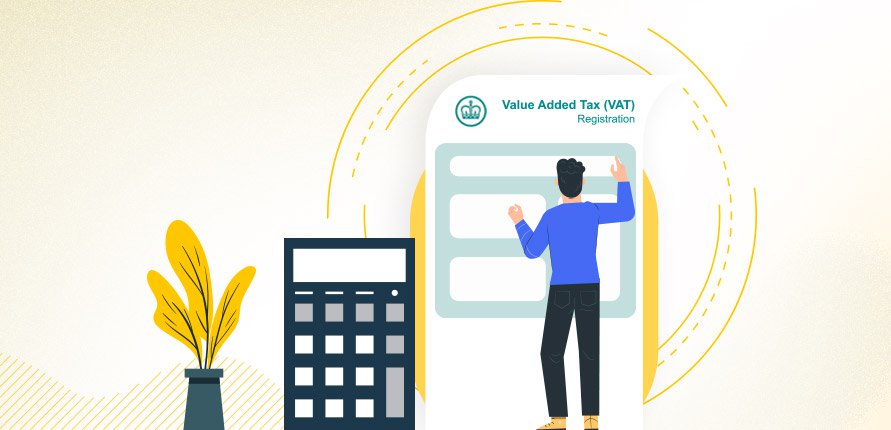
We think it’s safe to say that one of the most frequently asked questions we come across during our everyday operation is about VAT registration. VAT Thresholds are revised time and again and people are not aware of this major fact. There are special cases where VAT registration is compulsory but the businesses fail to do so and often face assessments followed by hefty interest charges and penalties.
This made us realise how important it is for us to make our readers and clients aware of the nuances of VAT registration. We`ve listened to you and wrapped up VAT Registration in a single guide.
VAT registration
A. Compulsory VAT registration
One needs to register for VAT if:
- Backward look: The business had a VAT taxable turnover of more than £85,000 over the period of the last 12 months. OR
- Forward look: It is expected that the VAT taxable turnover will go above £85,000 in the next 30-day period.
B. Voluntary VAT registration
The businesses with VAT taxable turnover of less than £85,000 can register for VAT voluntarily. Then, they will have to charge VAT and pay to HMRC any VAT owed from the date of registration.
C. Special cases of compulsory VAT registration
- A business supplying VAT exempt goods or services
If a business supplies goods or services exempt or “out of scope” of VAT only but use goods worth more than £85,000 bought from EU VAT registered suppliers in the said business, then such a supplier needs to register for VAT as soon as such buying exceed £85,000 limit. This means registration will be mandatory irrespective of the fact that all goods or services supplied by it are exempt or out of the scope of VAT. - Businesses outside the UK
Where the business and its owner both are based outside the UK, and if they supply or are expecting to supply goods and services into the UK within the next 30 days, then they need to compulsorily register for VAT regardless of the VAT threshold. This means that if businesses outside the UK supply goods or services of even single penny into the UK, then such business will have to be registered for UK VAT. - Businesses making only zero-rated supplies
The zero rates is a VAT rate. Items falling under this tax bracket fall inside the gamut of the VAT regime. Though practically no VAT is charged they continue to be liable to register for VAT since they will be eligible for an input tax refund.
VAT taxable turnover
Section 4 of Value Added Tax Act 1994 states that:
“(1) VAT shall be charged on any supply of goods or services made in the United Kingdom, where it is a taxable supply made by a taxable person in the course or furtherance of any business carried on by him.
(2)A taxable supply is a supply of goods or services made in the United Kingdom other than an exempt supply.”
In other words, VAT taxable turnover means:
- Goods or services are supplied in the UK
- They are supplied in the course or progress of the business being carried on
- The taxable turnover shall not include exempt supplies (but include zero-rated items)
- While calculating taxable turnover, include:
- goods hired or loaned to customers
- business goods used for personal reasons
- goods bartered, part-exchanged or given away as gifts
- services received from business in other countries that were covered under reverse charge
- building work of over £100,000 business did for itself
When to register for VAT and the Effective date of registration
(Note: ‘Effective date of registration’ means the date from which businesses have to pay HMRC any VAT due)
| S. NO. | TYPE OF REGISTRATION | WHEN TO REGISTER? | EFFECTIVE DATE OF REGISTRATION |
| A | Compulsory VAT registration | ||
| (i) Backward look | Register within 30 days from the end of the month when the VAT threshold was crossed. | The effective date of registration shall be the first day of the second month after the VAT threshold is crossed. | |
| (ii) Forward look | If the VAT taxable turnover is expected to be more than £85,000 in the next 30-day period then register by the end of that 30-day period. | The effective date of VAT registration shall be the date on which it was realised that the VAT taxable turnover will go above £85,000 and not the date when turnover actually went over the threshold. | |
| B | Voluntary VAT Registration | Register whenever the need to register arises | Date when HMRC registers it under VAT |
Exception from registration
If the individual or the business feels that the taxable turnover has gone over VAT threshold temporarily, then it may write to HMRC that the turnover will not cross the deregistration threshold of £83,000 in the next 12 months along with necessary evidence to support it.
How to register for VAT?

Businesses can either register online or by post. The information required while registering a business for VAT includes turnover, business activity, bank details.
Most businesses can register for VAT online. However, some of the businesses need to register for VAT by post, they
| S. NO. | VAT REGISTRATION FORM | WHO CAN USE IT? |
| 1 | VAT 1 |
|
| 2 | VAT 1A | An EU business ‘distance selling’ to the UK |
| 3 | VAT 1B | Business importing goods worth more than £85,000 from another EU country |
| 4 | VAT 1C | Business disposing of assets on which 8th or 13th Directive refunds have been claimed |
Upon registration:
- HMRC sends a VAT number. This VAT number is then used to sign up for VAT online account, which is required to file a VAT return to HMRC.
- HMRC also sends a VAT registration certificate either to VAT online account or by post within 30 working days.
VAT Responsibilities

From the effective date of registration the business is responsible for:
- Charging the right amount of VAT
- Pay VAT due to HMRC
- Submit VAT returns
- Keep VAT records and a VAT account
- If the business turnover is more than £85,000 then it must follow rules relating to MTD for VAT
Purchases made prior to VAT registration
Businesses can claim the VAT back on some purchases and services made before registering for VAT. From the date of VAT registration the time limits are:
- 4 years for goods still present or that were used to make other goods that are still present.
- 6 months for service.
It is worth noting that VAT can be reclaimed on only those supplies which relate to the business now registered for VAT. Also, these supplies must be used for ‘business purpose’ only.
Changes in VAT registration details
The VAT registration details need to be kept up to date otherwise it may cause a business to face a financial penalty. Details can be changed either via VAT online account or by post using VAT 484.
| S. NO. | CHANGE | REPORT TO WHOM? | REPORTING PERIOD |
| 1 | Change in name, trading name or main address of the business | HMRC | 30 days after the change |
| 2 | Change in the accountant or agent who deals with business’ VAT | HMRC | 30 days after the change |
| 3 | Change in the members of a partnership, or the name or home address of any of the partners | HMRC | 30 days after the change |
| 4 | Change in bank details | HMRC | 14 days before the change |
| 5 | Change in Direct Debit details if VAT is paid by Direct Debit | Bank | 5 banking days before or after the VAT return is due |
| 6 | If one takes on the VAT responsibilities of someone who has died or is ill | HMRC | 21 days from taking up such responsibility |
Where the change is such that the business becomes ineligible for VAT registration then there might be a need to cancel the VAT registration itself.
Transfer of VAT registration
VAT registration can be transferred from one business to another or if there is a change in the status (eg. sole trader to a limited company) of the business. The transfer can be done online through the VAT online account or by post using VAT 68.
Cancellation of VAT registration

If the business is no longer eligible to be VAT registered then it can get its VAT registration canceled. You need to cancel your VAT registration under these circumstances;
- The business stops trading or making taxable supplies.
- The business joins a VAT group.
- If the VAT taxable turnover goes below the deregistration threshold of £83,000.
It is important to note that the registration must be canceled within 30 days if the business stops being eligible or else a penalty may be charged. It can be canceled either by VAT online account or by sending VAT 7 by post. From the date of cancellation, the businesses must stop charging VAT and keep their VAT records for 6 years.
Another important point to remember is that the businesses who cancel their registration need to submit a final VAT Return for the period up to and including the cancellation date. They must account for any stock and other assets they have on this date if they were eligible to reclaim VAT when they bought the said stock and assets and the total VAT due on these assets is over £1,000.
Late registration
If the business fails to register by the date it ought to be registered for VAT, then it would be required to pay VAT equivalent to what it owes from the date when it should have been registered. There might be a penalty based on the amount owed and how late the registration is. If you are lucky this burden may be reduced if HMRC chooses to apply the concession of liable no longer liable in its assessment. The concept of liable no longer liable has been discussed in the following para.
Liable no longer liable
The concept of ‘liable no longer liable’ is applied to the cases where a business has a fluctuating turnover such that it goes over and under the VAT threshold often. The business, however, fails to register for VAT. In such cases, HMRC may turn out to be lenient and generously apply ‘liable no longer liable’ to register the business for VAT only for the period for which the business crossed the VAT threshold instead of registering it till the date of assessment. This concept is based on the premise that the taxpayer would have deregistered for VAT when their taxable turnover declines below the threshold.
Conclusion
We’ve tried to put in all the aspects related to a VAT registration in the simplest of words possible. Hope this would help you understand this matter well and keep you alert as to when you need to register or deregister or cancel the registration. If you have any queries you can drop them here or call us on 020 3960 5080.
Further reading:
- Understanding Value Added Tax (VAT)
- Deferral of VAT payments - COVID19
- Claiming VAT Back
- Capital goods scheme for VAT
- Reverse charge VAT on construction services: OVERVIEW
- Making Tax Digital – April 2019












